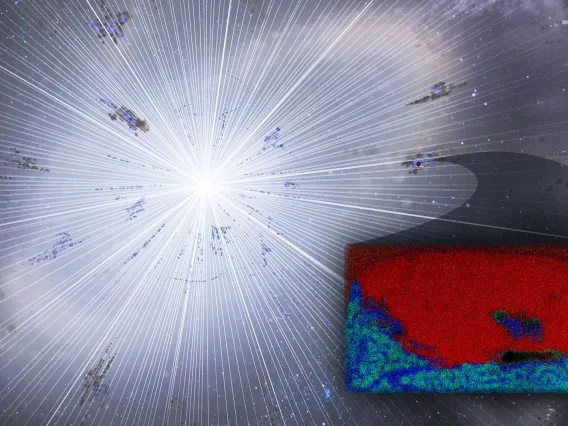
Ashes of a Dying Star Hold Clues about Solar System's Birth
A dust grain forged in a stellar explosion predating our solar system reveals new insights about how stars end their lives and seed the universe with the building blocks of new stars and planets.
Ashes of a Dying Star Hold Clues about Solar System's Birth
×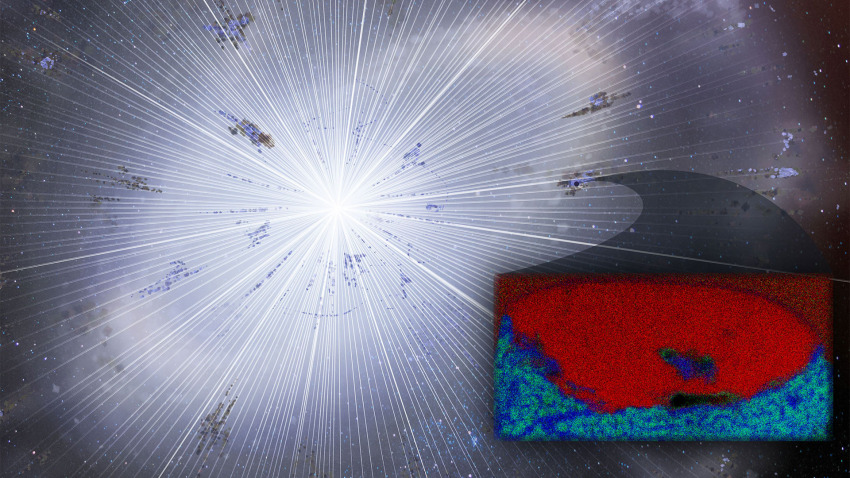
By Daniel Stolte, University Communications - April 29, 2019
A grain of dust forged in the death throes of a long-gone star was discovered by a team of researchers led by the University of Arizona.
The discovery challenges some of the current theories about how dying stars seed the universe with raw materials for the formation of planets and, ultimately, the precursor molecules of life.
Tucked inside a chondritic meteorite collected in Antarctica, the tiny speck represents actual stardust, most likely hurled into space by an exploding star before our own sun existed. Although such grains are believed to provide important raw materials contributing to the mix from which the sun and our planets formed, they rarely survive the turmoil that goes with the birth of a solar system.
"As actual dust from stars, such presolar grains give us insight into the building blocks from which our solar system formed," said Pierre Haenecour, lead author of the paper that was published in Nature Astronomy. "They also provide us with a direct snapshot of the conditions in a star at the time when this grain was formed."
Dubbed LAP-149, the dust grain represents the only known assemblage of graphite and silicate grains that can be traced to a specific type of stellar explosion called a nova. Remarkably, it survived the journey through interstellar space and traveled to the region that would become our solar system some 4.5 billion years ago, perhaps earlier, where it became embedded in a primitive meteorite.
Novae are binary star systems in which a core remnant of a star, called a white dwarf, is on its way to fading out of the universe, while its companion is either a low-mass main sequence star or a red giant. The white dwarf then begins syphoning material off its bloated companion. Once it accretes enough new stellar material, the white dwarf re-ignites in periodic outbursts violent enough to forge new chemical elements from the stellar fuel and spew them deep into space, where they can travel to new stellar systems and become incorporated in their raw materials.
Since shortly after the Big Bang, when the universe consisted of only hydrogen, helium and traces of lithium, stellar explosions have contributed to the chemical enrichment of the cosmos, resulting in the plethora of elements we see today.
Taking advantage of sophisticated ion and electron microscopy facilities at the UA's Lunar and Planetary Laboratory, a research team led by Haenecour analyzed the microbe-sized dust grain down to the atomic level. The tiny messenger from outer space turned out to be truly alien – highly enriched in a carbon isotope called 13C.
"The carbon isotopic compositions in anything we have ever sampled that came from any planet or body in our solar system varies typically by a factor on the order of 50," said Haenecour, who will join the Lunar and Planetary Laboratory as an assistant professor in the fall. "The 13C we found in LAP-149 is enriched more than 50,000-fold. These results provide further laboratory evidence that both carbon- and oxygen-rich grains from novae contributed to the building blocks of our solar system."
Although their parent stars no longer exist, the isotopic and chemical compositions and microstructure of individual stardust grains identified in meteorites provide unique constraints on dust formation and thermodynamic conditions in stellar outflows, the authors wrote.
Detailed analysis revealed even more unexpected secrets: Unlike similar dust grains thought to have been forged in dying stars, LAP-149 is the first known grain consisting of graphite that contains an oxygen-rich silicate inclusion.
"Our find provides us with a glimpse into a process we could never witness on Earth," Haenecour added. "It tells us about how dust grains form and move around inside as they are expelled by the nova. We now know that carbonaceous and silicate dust grains can form in the same nova ejecta, and they get transported across chemically distinct clumps of dust within the ejecta, something that was predicted by models of novae but never found in a specimen."
Unfortunately, LAP-149 does not contain enough atoms to determine its exact age, so researchers hope to find similar, larger specimens in the future.
"If we could date these objects someday, we could get a better idea of what our galaxy looked like in our region and what triggered the formation of the solar system," said Tom Zega, scientific director of the UA's Kuiper-Arizona Laboratory for Astromaterials and associate professor in the Lunar and Planetary Laboratory and UA Department of Materials Science and Engineering. "Perhaps we owe our existence to a nearby supernova explosion, compressing clouds of gas and dust with its shockwave, igniting stars and creating stellar nurseries, similar to what we see in Hubble's famous 'Pillars of Creation' picture."
The meteorite containing the speck of stardust is one of the most pristine meteorites in the Lunar and Planetary Laboratory's collection. Classified as a carbonaceous chondrite, it is believed to be analogous to the material on Bennu, the target asteroid of the UA-led OSIRIS-REx mission. By taking a sample of Bennu and bringing it back to Earth, the OSIRIS-REx mission team hopes to provide scientists with material that has seen little, if any, alteration since the formation of our solar system.
Until then, researchers depend on rare finds like LAP-149, which survived being blasted from an exploding star, caught in a collapsing cloud of gas and dust that would become our solar system and baked into an asteroid before falling to the earth.
"It's remarkable when you think about all the ways along the way that should have killed this grain," Zega said.
For a complete list of authors who contributed to this study and their affiliations, please see the paper, "Laboratory evidence for co-condensed oxygen- and carbon-rich meteoritic stardust from nova outbursts," Nature Astronomy, DOI: 10.1038/s41550-019-0757-4. Support for this study was provided by organizations including NASA and the National Science Foundation, which also supports the UA Kuiper Material Imaging and Characterization Facility, which made the detailed analysis of the LAP-149 sample possible.

Powerful Particles and Tugging Tides May Affect Extraterrestrial Life
Two new studies by UA space scientists may bring into question the habitability of TRAPPIST-1 exoplanets, three of which are in the habitable zone of space.
Powerful Particles and Tugging Tides May Affect Extraterrestrial Life
×
By Emily Walla, University Communications - April 16, 2019
Since its discovery in 2016, planetary scientists have been excited about TRAPPIST-1, a system where seven Earth-sized rocky planets orbit a cool star. Three of the planets are in the habitable zone, the region of space where liquid water can flow on the planets’ surfaces. But two new studies by scientists in the University of Arizona’s Lunar and Planetary Laboratory may lead astronomers to redefine the habitable zone for TRAPPIST-1.
The three planets in the habitable zone are likely facing a formidable opponent to life: high-energy particles spewed from the star. For the first time, Federico Fraschetti and a team of scientists from the Center for Astrophysics | Harvard & Smithsonian have calculated how hard these particles are hitting the planets.
Meanwhile, Hamish Hay, a graduate student in the Lunar and Planetary Laboratory, has found that the gravitational tug-of-war the TRAPPIST-1 planets are playing with one another is raising tides on their surfaces, possibly driving volcanic activity or warming ice-insulated oceans on planets that are otherwise too cold to support life.
Both Fraschetti’s paper and Hay's study, “Tides between TRAPPIST-1 planets,” are recently published in the Astrophysical Journal.
Punchy Protons
The system’s star, TRAPPIST-1A, is smaller, less massive and 6,000 degrees Fahrenheit cooler than our 10,000-degree sun. It is also extremely active, meaning it emits huge amounts of high-energy protons – the same particles that cause auroras on Earth.
Fraschetti and his team simulated the journeys of these high-energy particles through the magnetic field of the star. They found that the fourth planet – the innermost of the worlds inside the TRAPPIST-1 habitable zone– may be experiencing a powerful bombardment of protons.
"The flux of these particles in the TRAPPIST-1 system can be up to 1 million times more than the particles flux on Earth," Fraschetti said.
This came as a surprise to the scientists, even though the planets are much closer to their star than Earth is to the sun. High-energy particles are carried through space along magnetic fields, and TRAPPIST-1A’s magnetic field is tightly wound around the star.
"You expect that the particles would get trapped in these tightly wrapped magnetic field lines, but if you introduce turbulence, they can escape, moving perpendicularly to the average stellar field," Fraschetti said.
Flares on the surface of the star cause turbulence in the magnetic field, allowing the protons to sail away from the star. Where the particles go depends on how the star’s magnetic field is angled away from its axis of rotation. In the TRAPPIST-1 system, the most likely alignment of this field will bring energetic protons directly to the fourth planet’s face, where they could break apart complex molecules that are needed to build life – or perhaps they could serve as catalysts for the creation of these molecules.
While Earth’s magnetic field protects most of the planet from energetic protons emitted by our sun, a field strong enough to deflect TRAPPIST-1’s protons would need to be improbably strong – hundreds of times more powerful than Earth’s. But this does not necessarily spell death for life in the TRAPPIST-1 system.
The TRAPPIST-1 planets are likely tidally locked, for one thing, meaning that the same hemisphere of each planet always faces the star, while perpetual night enshrouds the other.
"Maybe the night side is still warm enough for life, and it doesn’t get bombarded by radiation," said Benjamin Rackham, a research associate with UA Department of Astronomy who was not involved with either study.
Oceans could also shield against destructive high-energy protons, as deep water could absorb the particles before they tear apart the building blocks of life. Tides raised in these oceans and even in the rocks of the planets might have other interesting implications for life.
Tugging Tides
On Earth, the moon raises tides not only in the oceans – tidal forces deform the spherical shape of Earth’s mantle and crust, as well. In the TRAPPIST-1 system, the planets are close enough together that scientists hypothesized the worlds might be raising tides on one another, as the moon does to Earth.
"When a planet or moon deforms from tides, friction inside it will create heating," said Hay, lead author of the second study.
By calculating how the gravity of TRAPPIST-1’s planets would tug on and deform each other, Hay explored how much heat tides bring to the system.
TRAPPIST-1 is the only known system where planets can raise significant tides on each other because the worlds are so tightly packed around their star.
"It’s such a unique process that no one’s thought about in detail before, and it’s kind of amazing that it’s actually a thing that happens," Hay said. In the past, scientists had only considered tides raised by the star.
Hay found that the inner two planets of the system come close enough together that they raise powerful tides on each other. It is possible the subsequent tidal heating may be strong enough to fuel volcanic activity, which can in turn sustain atmospheres. Though TRAPPIST-1’s innermost planets are likely too hot on their day side to sustain life, a volcano-fueled atmosphere could help move some heat to their otherwise-too-cold night side, warming it enough to keep living things from freezing.
The sixth planet in the system, called TRAPPIST-1g, is experiencing tidal tugging from both the star and the other planets. It is the only planet in the system where tidal heating due to the other planets is as strong as that caused by the central star. If TRAPPIST-1g is an ocean world, like Europa or Enceladus in our own solar system, tidal heating could keep its waters warm.
M-dwarf star systems like TRAPPIST-1 offer astronomers the best opportunity to search for life outside the solar system, and Fraschetti and Hay’s studies may help scientists choose how to explore the system in the future.
"We need to really understand the suitability of these systems for life, and energetic particle fluxes and tidal heating are important factors to constrain our ability to do that," Rackham said.

Congratulations to Dr. Michael M. Sori!
Dr. Michael Sori was
Congratulations to Dr. Michael M. Sori!
×
Dr. Michael Sori was presented with the Outstanding Postdoctoral Scholar Award at the 2019 Awards of Distinction Luncheon and Ceremony, on April 1st.
After receiving his PhD in Planetary Science at the Massachusetts Institute of Technology, Dr. Michael Sori joined the University of Arizona Lunar and Planetary Sciences Laboratory in 2014 to pursue postdoctoral training under the mentorship of Dr. Christopher Hamilton and Dr. Shane Byrne. Dr. Sori’s research spans a variety of topics in planetary geophysics, including the origin and evolution of ices and what they tell us about the climates and orbital histories of planets, and how volcanism helps to shape planetary surfaces. Using remote sensing data from spacecraft to inform his geophysical models, he has contributed greatly to the study the Moon, Mars, Ceres, and Uranian satellites.
Dr. Sori has made outstanding contributions to University of Arizona’s research, outreach, and teaching missions. Since beginning his tenure as a postdoctoral scholar, he has obtained his own funding through NASA and published 14 peer-reviewed articles in high-profile journals such as Nature and Science. These publications illustrate the breadth of his technical ability and understanding of fundamental scientific problems. His discoveries have caught the public’s eye, with one being among the University’s highest profile news stories in 2018. His classroom teaching and mentoring have also earned him the reputation of being a “natural educator.” The University of Arizona is privileged to serve as the postdoctoral home for Michael Sori who is, in the words of his nominators, “a talented and reliable collaborator, an insightful scientist, a great mentor, and a respected role model within our department and within the broader Planetary Sciences community.”

Alfred McEwen Appointed Regents' Professor
University
Alfred McEwen Appointed Regents' Professor
×
University Communications - April 15, 2019
The Arizona Board of Regents on April 11 confirmed the appointments of University of Arizona faculty members Alfred McEwen, John Rutherfoord, Dr. Marvin Slepian, Rod Wing and Lucy Ziurys as Regents' Professors.
The title of Regents’ Professor is reserved for full professors whose exceptional achievements merit national and international distinction. Regents' Professor appointments are limited to no more than 3 percent of the total number of the university’s tenured and tenure track faculty members.
Alfred McEwen is the principal investigator for the High Resolution Imaging Science Experiment, or HiRISE, on the Mars Reconnaissance Orbiter. HiRISE has produced extremely-high-resolution images of the Martian surface since the launch of the Mars Reconnaissance Orbiter in 2005.
McEwen has made two discoveries about the geology of Mars from his detailed analyses of HiRISE and other Martian data. First, McEwen says Martian slopes show enigmatic flows that are actively forming at the present day and may provide evidence for water on Mars. Second, McEwen has shown that the practice of counting small craters is not always a reliable indicator of the age of a planetary surface, as many small craters can be produced from the high-velocity ejecta of larger impacts.
McEwen’s work has helped change the scientific viewpoint of Mars from that of a dead planet to one with a dynamic surface, largely as a result of science done using the HiRISE camera, the construction and operations of which he has led for more than a decade.
McEwen’s accomplishments were recognized with a NASA Distinguished Public Service Medal in 2011, the American Geophysical Union Whipple Award in 2015, and designation as a UA College of Science Galileo Circle Fellow in 2015.
McEwen, a planetary geologist, has been a member of the UA faculty since 1996. He is a professor of planetary sciences at the UA Lunar and Planetary Laboratory, a professor of geosciences and director of the Planetary Image Research Laboratory. In addition to HiRISE, his spacecraft involvement currently includes being co-investigator on the Colour and Stereo Surface Imaging System on the ExoMars Trace Gas Orbiter, launched in 2016, co-investigator on the LROC team on the Lunar Reconnaissance Orbiter mission to the moon, and deputy principle investigator of the Europa Imaging System on the Europa Clipper million, to launch in 2022 or later. Previously, McEwen was a member of the imaging science team of the Cassini mission to Saturn, which began in 1990 and ended in 2018, among other missions.
He is also a devoted educator. McEwen designed the “Mars” course for upper-level graduates and has served as a mentor for many students at all degree levels.
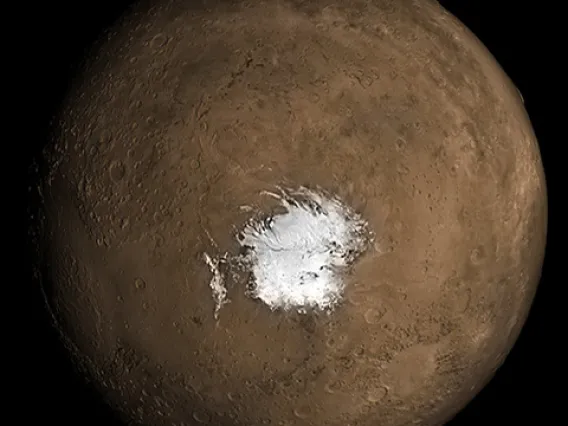
UA Study Suggests Possibility of Recent Underground Volcanism on Mars
A new study conducted by LPL scientists suggests volcanoes may have been recently boiling deep below the surface of the Red Planet, which could explain the potential presence of liquid water underneath the polar ice caps.
UA Study Suggests Possibility of Recent Underground Volcanism on Mars
×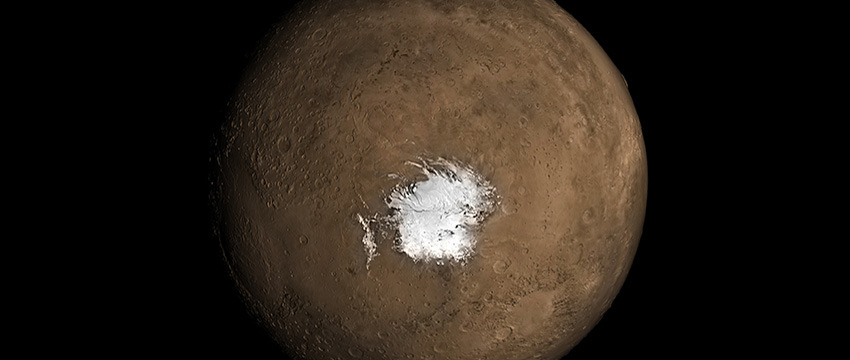
By American Geophysical Union - February 14, 2019
A study published last year suggested liquid water is present beneath the south polar ice cap of Mars. Now, a new study in the American Geophysical Union journal Geophysical Research Letters argues there needs to be an underground source of heat for liquid water to exist underneath the polar ice cap.
The new research does not take sides as to whether the liquid water exists. Instead, the authors suggest that recent magmatic activity – the formation of a magma chamber within the past few hundred thousand years – must have occurred underneath the surface of Mars for there to be enough heat to produce liquid water underneath the thick ice cap. On the flip side, the study’s authors argue that if there was not recent magmatic activity underneath the surface of Mars, then it is not likely there is liquid water underneath the ice cap.
“Different people may go different ways with this, and we’re really interested to see how the community reacts to it,” said Michael Sori, an associate staff scientist in the Lunar and Planetary Laboratory at the University of Arizona and a co-lead author of the new paper.
The potential presence of recent underground magmatic activity on Mars lends weight to the idea that Mars is an active planet, geologically speaking. That notion could give scientists a better understanding of how planets evolve over time.
The new study is intended to further the debate around the possibility of liquid water on Mars. The presence of liquid water on the Red Planet has implications for potentially finding life outside of Earth and could also serve as a resource for future human exploration of our neighboring planet.
“We think that if there is any life, it likely has to be protected in the subsurface from the radiation,” said Ali Bramson, a postdoctoral research associate at the Lunar and Planetary Laboratory and a co-lead author of the paper. “If there are still magmatic processes active today, maybe they were more common in the recent past and could supply more widespread basal melting. This could provide a more favorable environment for liquid water and thus, perhaps, life.”
Examining the environment
Mars has two giant ice sheets at its poles, both about a mile thick. On Earth, it is common for liquid water to be present underneath thick ice sheets, with the planet’s heat causing the ice to melt where it meets the Earth’s crust.
In a paper published last year in Science, scientists said they detected a similar phenomenon on Mars. They claimed radar observations detected evidence of liquid water at the base of Mars’ south polar ice cap; however, the study did not address how liquid water could have gotten there.
Mars is much cooler than Earth, so it was unclear what type of environment would be needed to melt the ice at the base of the ice cap. Although previous research examined if liquid water could exist at the base of Mars’ ice caps, no one had yet looked at the specific location where scientists claimed to have detected water.
“We thought there was a lot of room to figure out if (the liquid water) is real, what sort of environment would you need to melt the ice in the first place, what sort of temperatures would you need, what sort of geological process would you need? Because under normal conditions, it should be too cold,” Sori said.
Looking for the heat
In the new study, Sori and his co-authors first assumed the detection of liquid water underneath the ice cap was correct and then worked to figure out what parameters were needed for the water to exist. They performed physical modeling of Mars to understand how much heat is coming out of the interior of the planet and if there could be enough salt at the base of the ice cap to melt the ice. Salt lowers the melting point of ice significantly, so it was thought that salt could have led to melting at the base of the ice cap.
The model showed salt alone would not raise the temperature high enough to melt the ice. Instead, the authors propose there needs to be additional heat coming from Mars’ interior.
One plausible heat source would be volcanic activity in the planet’s subsurface. The study’s authors argue that magma from the deep interior of Mars rose towards the planet’s surface about 300,000 years ago. It did not break the surface, like a volcanic eruption, but pooled in a magma chamber below the surface. As the magma chamber cooled, it released heat that melted the ice at the base of the ice sheet. The magma chamber is still providing heat to the ice sheet to generate liquid water today.
The idea of volcanic activity on Mars is not new – there is a lot of evidence of volcanism on the planet’s surface. But most of the volcanic features on Mars are from millions of years ago, leading scientists to believe that volcanic activity below and above the planet’s surface stopped long ago.
The new study, however, proposes that there could have been more recent underground volcanic activity. And, according to the study’s authors, if there was volcanic activity happening hundreds of thousands of years ago, there’s a possibility it could be happening today.
“This would imply that there is still active magma chamber formation going on in the interior of Mars today, and it is not just a cold, sort of dead place, internally,” Bramson said.
Jack Holt, a professor at the at the Lunar and Planetary Laboratory, said the question of how water could exist underneath the south polar ice cap came to his mind immediately after the Science paper was published, and the new paper adds an important constraint on the possibility of water being there. He said it will likely add to the debate within the planetary science community about the finding and point out that more research needs to be done.
“I think it was a great idea to do this type of modeling and analysis because you have to explain the water, if it’s there. It’s really a critical piece of the puzzle,” said Holt, who was not involved in the research. “The original paper just left it hanging. There could be water there, but you have to explain it, and these guys did a really nice job of saying what is required and that salt is not sufficient.”
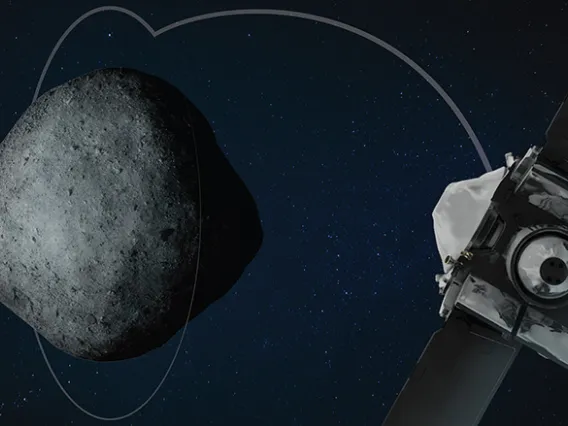
NASA’s OSIRIS-REx Spacecraft Enters Close Orbit Around Bennu, Breaking Record
By Erin Morton
NASA’s OSIRIS-REx Spacecraft Enters Close Orbit Around Bennu, Breaking Record
×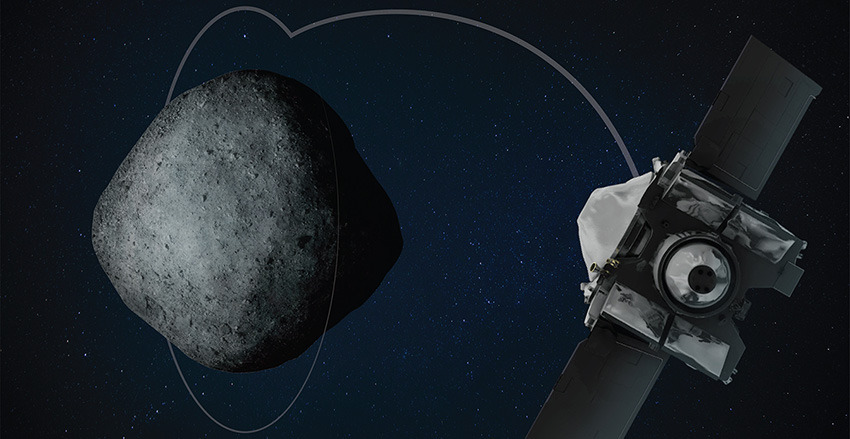
By Erin Morton, OSIRIS-REx Asteroid Sample Return Mission - December 31, 2018
At 2:43 p.m. EST on December 31, while many on Earth prepared to welcome the New Year, NASA’s OSIRIS-REx spacecraft, 70 million miles (110 million kilometers) away, carried out a single, eight-second burn of its thrusters – and broke a space exploration record. The spacecraft entered into orbit around the asteroid Bennu, and made Bennu the smallest object ever to be orbited by a spacecraft.
“The team continued our long string of successes by executing the orbit-insertion maneuver perfectly,” said Dante Lauretta, OSIRIS-REx principal investigator at the University of Arizona, Tucson. “With the navigation campaign coming to an end, we are looking forward to the scientific mapping and sample site selection phase of the mission.”
Lauretta, along with his team, spent the last day of 2018 with his feet planted on Earth, but his mind focused on space. “Entering orbit around Bennu is an amazing accomplishment that our team has been planning for years,” Lauretta said.
Inching around the asteroid at a snail’s pace, OSIRIS-REx’s first orbit marks a leap for humankind. Never before has a spacecraft from Earth circled so close to such a small space object – one with barely enough gravity to keep a vehicle in a stable orbit.
Now, the spacecraft will circle Bennu about a mile (1.75 kilometers) from its center, closer than any other spacecraft has come to its celestial object of study. (Previously the closest orbit of a planetary body was in May 2016, when the Rosetta spacecraft orbited about four miles (seven kilometers) from the center of the comet 67P/Churyumov-Gerasimenko.) The comfortable distance is necessary to keep the spacecraft locked to Bennu, which has a gravity force only 5-millionths as strong as Earth’s. The spacecraft is scheduled to orbit Bennu through mid-February at a leisurely 62 hours per orbit.
Now that the OSIRIS-REx spacecraft is closer to Bennu, physical details about the asteroid will leap into sharper focus, and the spacecraft’s tour of this rubble pile of primordial debris will become increasingly detailed and focused.
“Our orbit design is highly dependent on Bennu’s physical properties, such as its mass and gravity field, which we didn’t know before we arrived,” said OSIRIS-REx’s flight dynamics system manager Mike Moreau, who is based at NASA’s Goddard Space Flight Center in Greenbelt, Maryland.
“Up until now, we had to account for a wide variety of possible scenarios in our computer simulations to make sure we could safely navigate the spacecraft so close to Bennu. As the team learned more about the asteroid, we incorporated new information to hone in on the final orbit design,” he said.
The simulations have played a critical role. The OSIRIS-REx mission, after all, was designed based on complex computer programs that predicted — quite accurately, as it turns out — the properties of Bennu and how the spacecraft’s trajectory would behave. This diligent preparation allowed the team to navigate the vehicle safely to Bennu in December and put some questions to rest (there are, indeed, signs of ancient water preserved in Bennu’s rocks) and to fly over its poles and equator in a preliminary survey that led to some surprises (Bennu has many large boulders).
Having completed the preliminary survey of Bennu with a flyby of its south pole on December 16, the spacecraft moved to a safe 31 miles (50 kilometers) away from the asteroid to give the navigation team a chance to regroup and prepare for orbit insertion. Next, Lockheed Martin engineers programmed the spacecraft to begin moving back to a position about nine miles (15 kilometers) over Bennu’s north pole to prepare for three burns of its thrusters over the course of 10 days that would place the spacecraft into orbit.
Even though OSIRIS-REx is in the most stable orbit possible, Bennu’s gravitational pull is so tenuous that keeping the spacecraft safe will require occasional adjustments, said Dan Wibben, OSIRIS-REx maneuver and trajectory design lead at KinetX Aerospace in Simi Valley, California.
“The gravity of Bennu is so small, forces like solar radiation and thermal pressure from Bennu’s surface become much more relevant and can push the spacecraft around in its orbit much more than if it were orbiting around Earth or Mars, where gravity is by far the most dominant force,” he said.
The OSIRIS-REx navigation team will use “trim” maneuvers to slightly thrust the spacecraft in one direction or another to correct its orbit and counter these small forces. If the spacecraft drifts away from Bennu, or some other problem forces it into safe mode, it has been programmed to fly away from the asteroid to stay safe from impact.
“It’s simple logic: always burn toward the Sun if something goes wrong,” said Coralie Adam, OSIRIS-REx lead optical navigation engineer at KinetX. Engineers can navigate the spacecraft back into orbit if it drifts away, Adam said, though that’s unlikely to happen.
The navigation and spacecraft operations teams are focused on the first orbital phase. Their primary goal is to transition away from star-based navigation, which allowed the team to locate the spacecraft based on pictures of the star formations around it taken by the cameras onboard. Navigators use methods like this since there is no GPS in deep space and we can’t see the spacecraft from Earth-based telescopes. From this point forward, though, the OSIRIS-REx team will rely on landmarks on Bennu’s surface to track OSIRIS-REx, a more precise technique that will ultimately guide them to a sample-collection site clear of boulders and large rocks, said Adam.
“After conducting a global imaging and mapping campaign during our recent preliminary survey phase, the science team has created 3-D models of Bennu’s terrain that we’re going to begin using for navigation around the asteroid,” she said.
Another critical objective of this orbital phase, Adam said, is to get a better handle on Bennu’s mass and gravity, features that will influence the planning of the rest of the mission, notably the short touchdown on the surface for sample collection in 2020. In the case of Bennu, scientists can only measure these features by getting OSIRIS-REx very close to the surface to see how its trajectory bends from Bennu’s gravitational pull.
“The Orbital A phase will help improve our detailed models for Bennu’s gravity field, thermal properties, orientation, and spin rate,” said Wibben. “This, in turn, will allow us to refine our trajectory designs for the even more challenging flight activities we will perform in 2019.”
The December 31 maneuver to place the spacecraft into orbit about Bennu is the first of many exciting navigation activities planned for the mission. The OSIRIS-REx team will resume science operations in late February. At that point, the spacecraft will perform a series of close flybys of Bennu for several months to take high-resolution images of every square inch of the asteroid to help select a sampling site. During the summer of 2020, the spacecraft will briefly touch the surface of Bennu to retrieve a sample. The OSIRIS-REx mission is scheduled to deliver the sample to Earth in September 2023.
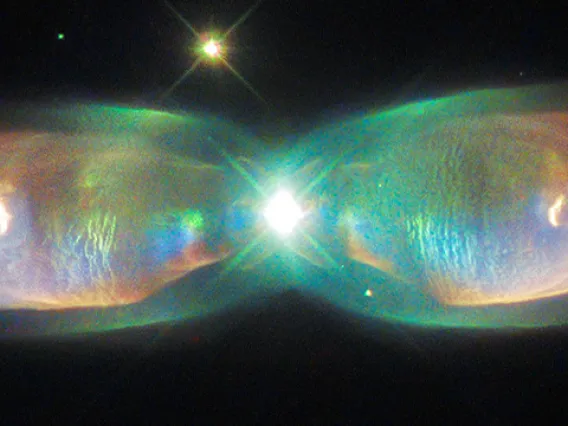
Stellar Corpse Reveals Clues to Missing Stardust
The origin of stardust, which makes up most of the matter in our solar system, including us, is more complicated than previously thought, according to new observations of a mysterious object 15,000 light-years from Earth.
Stellar Corpse Reveals Clues to Missing Stardust
×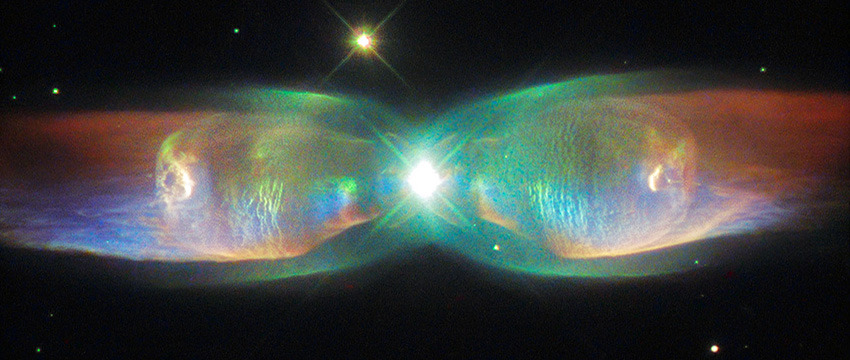
By Daniel Stolte, University Communications - December 19, 2018
Everything around you – your desk, your laptop, your coffee cup – in fact, even you – is made of stardust, the stuff forged in the fiery furnaces of stars that died before our sun was born. Probing the space surrounding a mysterious stellar corpse, scientists at the University of Arizona have made a discovery that could help solve a long-standing mystery: Where does stardust come from?
When stars die, they seed the cosmos around them with the elements that go on to coalesce into new stars, planets, asteroids and comets. Most everything that makes up Earth, even life itself, consists of elements made by previous stars, including silicon, carbon, nitrogen and oxygen. But this is not the whole story. Meteorites commonly contain traces of a type of stardust that, until now, was believed to form only in exceptionally violent, explosive events of stellar death known as novae or supernovae – too rare to account for the abundance preserved in meteorites.
Researchers at the UA used radio telescopes in Arizona and Spain to observe gas clouds in the young planetary nebula K4-47, an enigmatic object approximately 15,000 light-years from Earth. Classified as a nebula, K4-47 is a stellar remnant, which astronomers believe was created when a star not unlike our sun shed some of its material in a shell of outflowing gas before ending its life as a white dwarf.
To their surprise, the researchers found that some of the elements that make up the nebula – carbon, nitrogen and oxygen – are highly enriched with certain variants that match the abundances seen in some meteorite particles but are otherwise rare in our solar system: so-called heavy isotopes of carbon, nitrogen and oxygen, or 13C, 15N and 17O, respectively. These isotopes differ from their more common forms by containing an extra neutron inside their nucleus.
Fusing an additional neutron onto an atomic nucleus requires extreme temperatures in excess of 200 million degrees Fahrenheit, leading scientists to conclude those isotopes could only be formed in novae – violent outbursts of energy in aging binary star systems – and supernovae, in which a star blows itself apart in one cataclysmic explosion.
"The models invoking only novae and supernovae could never account for the amounts of 15N and 17O we observe in meteorite samples," said Lucy Ziurys, senior author of the paper, which is published in the Dec. 20 issue of the journal Nature. "The fact that we're finding these isotopes in K4-47 tells us that we don't need strange exotic stars to explain their origin. It turns out your average garden variety stars are capable of producing them as well."
In lieu of cataclysmic explosive events forging heavy isotopes, the team suggests they could be produced when an average-size star such as our sun becomes unstable toward the end of its life and undergoes a so-called helium flash, in which super-hot helium from the star's core punches through the overlaying hydrogen envelope.
"This process, during which the material has to be spewed out and cooled quickly, produces 13C, 15N and 17O," explained Ziurys, a professor with dual appointments in the UA's Steward Observatory and Department of Chemistry and Biochemistry. "A helium flash doesn't rip the star apart like a supernova does. It's more like a stellar eruption."
The findings have implications for the identification of stardust and the understanding of how common stars create elements such as oxygen, nitrogen and carbon, the authors said.
The discovery was made possible through a collaboration between disciplines that traditionally have remained relatively separate: astronomy and cosmochemistry. The team used radio telescopes at the Arizona Radio Observatory and Institut de Radioastronomie Millimetrique (IRAM) to observe rotational spectra emitted by the molecules in the K4-47 nebula, which reveal clues about their mass distribution and their identity.
"When Lucy and I started collaborating on this project, we realized that we could reconcile what we found in meteorites and what we observe in space," said co-author Tom Zega, associate professor of cosmochemistry, planetary materials and astrobiology in the UA's Lunar and Planetary Laboratory.
The researchers are eagerly awaiting the discoveries that lie ahead for NASA's OSIRIS-REx asteroid sample return mission, which is led by the UA. Just two weeks ago, the spacecraft arrived at its target asteroid, Bennu, from which it will collect a sample of pristine material in 2020. One of the mission's major goals is to understand the evolution of Bennu and the origins of the solar system.
"You can think of the grains we find in meteorites as stellar ashes, left behind by stars that had long died when our solar system formed," Zega said. "We expect to find those pre-solar grains on Bennu – they are part of the puzzle of the history of this asteroid, and this research will help define where the material on Bennu came from."
"We can now trace where those ashes came from," Ziurys added. "It's like an archeology of stardust."
"The study of explosive helium burning inside stars will start a new chapter in the story of the origin of the chemical elements," said Neville "Nick" Woolf, Professor Emeritus at Steward Observatory and the fourth co-author.
The article’s first author is Deborah Schmidt, a doctoral student at the Steward Observatory.
This research was funded by the National Science Foundation (Grant No. AST- 1515568) and NASA (Agreement No. NNX15AD94G).
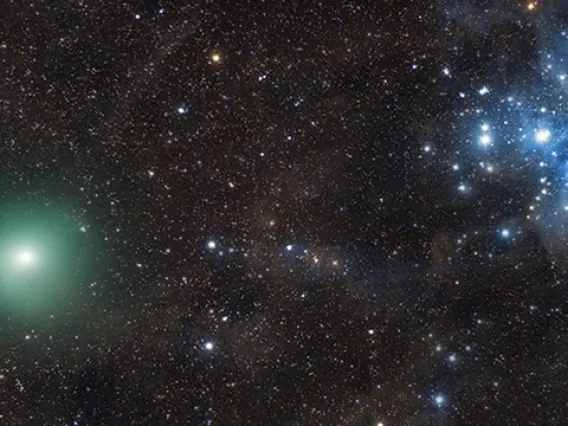
UA Researcher Captures Rare Radar Images of Comet 46P/Wirtanen
A LPL-led team took the best known opportunity for the next 30 years to image a comet with radar, resulting in some unique and surprising information about Comet 46P/Wirtanen.
UA Researcher Captures Rare Radar Images of Comet 46P/Wirtanen
×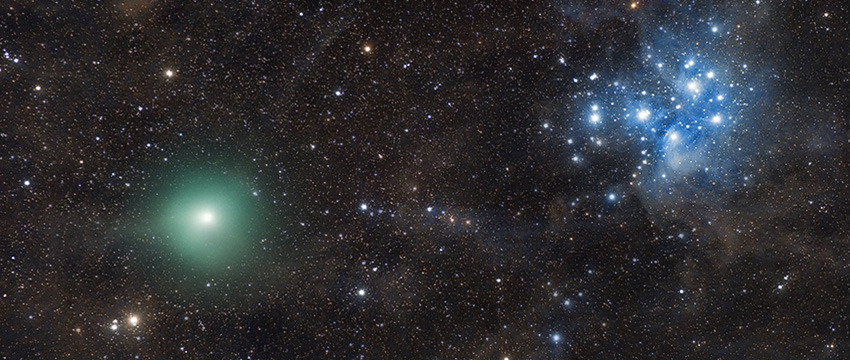
By Erin Morton, UA Lunar and Planetary Laboratory - December 20, 2018
Although barely visible to the naked eye, Comet 46P/Wirtanen keeps some secrets so close that only radar can uncover them.
As the comet was making its close approach to Earth on Dec. 16, it was studied by a team of scientists led by Ellen Howell from the UA's Lunar and Planetary Laboratory. The team used Arecibo Observatory’s planetary radar, which is supported by NASA’s Near-Earth Object Observations program.
Studying the comet with radar provides a glimpse of its nucleus, the solid portion of the comet usually hidden inside a cloud of gas and dust that makes up the coma and tail. Radar images also allow for a precise determination of the comet’s orbit, allowing scientists to better predict how the gas and dust emission can alter the orbit.
Arecibo Observatory, a facility of the National Science Foundation operated by the University of Central Florida, is the only radar facility with the sensitivity to acquire images of Comet 46P/Wirtanen’s nucleus during its flyby. The Arecibo radar observations of Comet 46P/Wirtanen began Dec. 10 and continued through Dec. 18.
The radar images of the nucleus revealed an elongated, somewhat lumpy body that is much rougher than others that have been studied.
The new radar observations provided the first definitive measurements of Comet 46P/Wirtanen’s diameter, which is approximately 0.9 miles (1.4 km). Previous size estimates of the diameter were derived from the comet’s brightness, but radar provides a more direct measurement.
Howell’s team, which included scientists from the University of Central Florida and the Lunar and Planetary Institute, was also able to observe the comet’s large-grain coma, which is only detectable to radar. They discovered that it contains a significant population of particles, defined as those just under an inch (2 cm) and larger. This coma skirt, seen in some but not all comets observed with radar, is very extensive and asymmetric in this active comet.
“Radar observations give us images of the comet nucleus we can’t get any other way. This comet has a really rugged looking surface, which might be related to the large population of grains in its coma,” said Howell, a senior research scientist at the Lunar and Planetary Laboratory. “Every comet we study is unique. Radar images are important pieces of the puzzle.”
Howell’s team was also able to find some surprising differences between this and other comets of the same family.
Comet 46P/Wirtanen is one of a group of comets called Jupiter family comets, as their orbits are controlled by Jupiter’s gravity. Two other Jupiter family comets, 45P/Honda-Mrkos-Pajdusakova and 41P/Tuttle-Giacobini-Kresak, were also recently studied by radar in 2017.
Although the three comets have similar orbits and activity levels, the radar observations show that they are actually quite different, especially with regard to the large grains in the coma. Comet 46P/Wirtanen has a large population of large grains, 45P/Honda-Mrkos-Pajdusakova has a smaller population of these grains, but 41P/Tuttle-Giacobini-Kresak had none.
Comet 46P/Wirtanen made its closest approach of Earth at about 7.2 million miles (11.6 million km), or 30 Earth-Moon distances, at a speed of over 22 thousand miles per hour (10 km/sec) relative to Earth. Howell’s team collaborated with a larger UA research group, headed by Lunar and Planetary Laboratory professor Walter Harris, to observe the comet at many different wavelengths during the pass to characterize the gas and dust emanating from the nucleus that forms the coma.
Comets are remnants of the planet-forming process, and are part of a group of objects made of water, ice and rocky material that formed beyond Neptune. The study of these objects gives us an idea of how our solar system formed and evolved over time.
This comet is only the eighth imaged using radar in the last 30 years, as comets rarely come close enough to the Earth to get detailed images. In fact, although 46P/Wirtanen has an orbital period of about 5.44 years, it rarely passes this close to Earth. The next close approach by Comet 46P/Wirtanen will be in 2029, but during that approach the comet will be 10 times farther away from the Earth than it is now.
This flyby was the best known opportunity to image a comet with radar for the next 30 years.
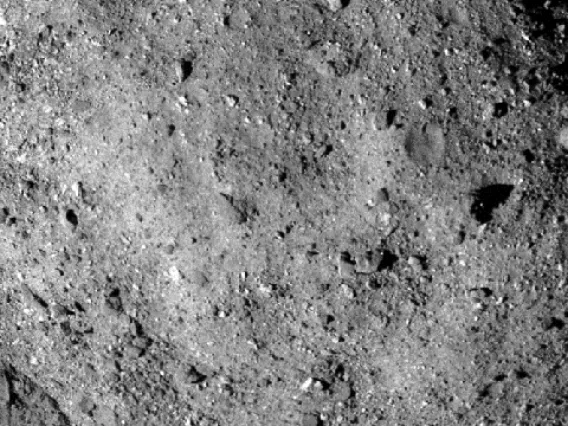
UA-Led OSIRIS-REx Discovers Water on Asteroid Bennu
Observations made by the spacecraft during its approach of Bennu reveal that the asteroid interacted with water in its early history and is an excellent specimen for the mission, which is slated to return a sample of surface material to Earth in 2023.
UA-Led OSIRIS-REx Discovers Water on Asteroid Bennu
×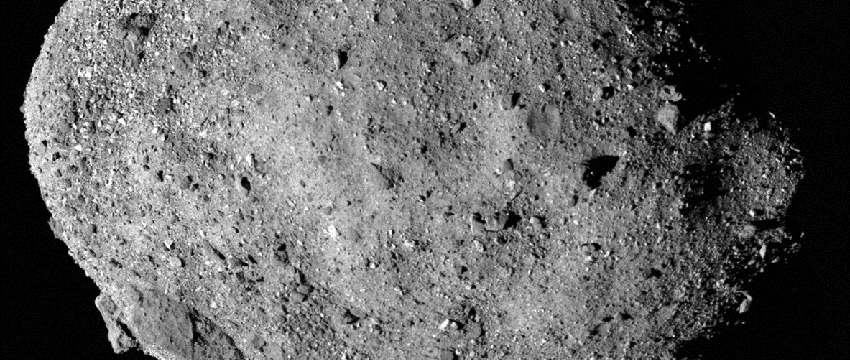
By Erin Morton/OSIRIS-REx and Daniel Stolte/University Communications - December 10, 2018
From August through early December, the OSIRIS-REx spacecraft aimed three of its science instruments toward Bennu and began making the mission's first observations of the asteroid. During this period, the spacecraft traveled the last 1.4 million miles (2.2 million km) of its outbound journey to arrive at a spot 12 miles (19 km) from Bennu on Dec. 3. The science obtained from these initial observations confirmed many of the mission team's ground-based observations of Bennu and revealed several new surprises.
Team members of the mission, which is led by the University of Arizona, presented the results at the Annual Fall Meeting of the American Geophysical Union, or AGU, in Washington, D.C. on Dec. 10.
In a key finding for the mission's science investigation, data obtained from the spacecraft's two spectrometers — the OSIRIS-REx Visible and Infrared Spectrometer, or OVIRS, and the OSIRIS-REx Thermal Emissions Spectrometer — reveal the presence of molecules that contain oxygen and hydrogen atoms bonded together, known as "hydroxyls." The team suspects that these hydroxyl groups exist globally across the asteroid in water-bearing clay minerals, meaning that at some point, the rocky material interacted with water. While Bennu itself is too small to have ever hosted liquid water, the finding does indicate that liquid water was present at some time on Bennu's parent body, a much larger asteroid.
"This finding may provide an important link between what we think happened in space with asteroids like Bennu and what we see in the meteorites that scientists study in the lab," said Ellen Howell, senior research scientist at the UA's Lunar and Planetary Laboratory, or LPL, and a member of the mission's spectral analysis group. "It is very exciting to see these hydrated minerals distributed across Bennu's surface, because it suggests they are an intrinsic part of Bennu's composition, not just sprinkled on its surface by an impactor."
"The presence of hydrated minerals across the asteroid confirms that Bennu, a remnant from early in the formation of the solar system, is an excellent specimen for the OSIRIS-REx mission to study the composition of primitive volatiles and organics," said Amy Simon, OVIRS Deputy Instrument Scientist at NASA Goddard Space Flight Center.
Additionally, data obtained from the OSIRIS-REx Camera Suite, or OCAMS, corroborate ground-based radar observations of Bennu and confirm that the original model — developed in 2013 by OSIRIS-REx Science Team Chief Michael Nolan, now based at LPL, and collaborators — closely predicted the asteroid's actual shape. Bennu's diameter, rotation rate, inclination and overall shape presented almost exactly as projected.
Soon after the asteroid later named Bennu was discovered in 1999, Nolan's group used the Arecibo Observatory in Puerto Rico to gather clues about its size, shape and rotation by bouncing radar waves off of it during one of its close approaches to Earth, about five times the distance between Earth and the moon.
"Radar observations don't give us any information about colors or brightness of the object, so it is really interesting to see the asteroid up close through the eyes of OSIRIS-REx," Nolan said. "As we are getting more details, we are figuring out where the craters and boulders are, and we were very pleasantly surprised that virtually every little bump we saw in our radar image back then is actually really there."
The mission team used this ground-based Bennu model when designing the OSIRIS-REx mission. The accuracy of the model means that the mission, spacecraft, and planned observations were appropriately designed for the tasks ahead at Bennu.
One outlier from the predicted shape model is the size of the large boulder near Bennu's south pole. The ground-based shape model calculated this boulder to be at least 33 feet (10 meters) in height. Preliminary calculations from OCAMS observations show that the boulder is closer to 164 feet (50 meters) in height, with a width of approximately 180 feet (55 meters).
As expected, the initial assessment of Bennu's regolith indicates that the surface of Bennu is a mix of very rocky, boulder-filled regions and a few relatively smooth regions that lack boulders. However, the quantity of boulders on the surface is higher than was expected. The team will make further observations at closer ranges to more accurately assess where a sample can be taken on Bennu for later return to Earth.
"Our initial data show that the team picked the right asteroid as the target of the OSIRIS-REx mission. We have not discovered any insurmountable issues at Bennu so far," said Dante Lauretta, OSIRIS-REx principal investigator and professor of planetary science and cosmochemistry at LPL. "The spacecraft is healthy and the science instruments are working better than required. It is time now for our adventure to begin."
"What used to be science fiction is now a reality," said UA President Robert C. Robbins. "Our work at Bennu brings us a step closer to the possibility of asteroids providing astronauts on future missions into the solar system with resources like fuel and water."
The mission is currently performing a preliminary survey of the asteroid, flying the spacecraft in passes over Bennu's north pole, equator and south pole at ranges as close as 4.4 miles (7 km) to better determine the asteroid's mass. This survey also provides the first opportunity for the OSIRIS-REx Laser Altimeter, an instrument contributed by the Canadian Space Agency, to make observations now that the spacecraft is in proximity to Bennu. The spacecraft's first orbital insertion is scheduled for Dec. 31, and OSIRIS-REx will remain in orbit until mid-February 2019, when the mission transitions into the next survey phase. During this first orbital phase, the spacecraft will orbit the asteroid at a range of 0.9 miles (1.4 km) to 1.24 miles (2 km) from the center of Bennu – setting two new records for the smallest body ever orbited by a spacecraft and the closest orbit of a planetary body by any spacecraft.
NASA's Goddard Space Flight Center in Greenbelt, Maryland, provides overall mission management, systems engineering and the safety and mission assurance for OSIRIS-REx. Lauretta is the principal investigator, and the UA also leads the science team and the mission's science observation planning and data processing. Lockheed Martin Space Systems in Denver built the spacecraft and is providing flight operations. Goddard and KinetX Aerospace are responsible for navigating the OSIRIS-REx spacecraft. OSIRIS-REx is the third mission in NASA's New Frontiers Program. NASA's Marshall Space Flight Center in Huntsville, Alabama, manages the agency's New Frontiers Program for the Science Mission Directorate in Washington.

UA Undergrad Works to ID OSIRIS-REx Touchdown Site
Systems engineering and mathematics double major Keara Burke is helping NASA's OSIRIS-REx spacecraft find the perfect place to collect samples at its far-flung destination, the asteroid Bennu.UA Undergrad Works to ID OSIRIS-REx Touchdown Site
×
By Emily Dieckman, UA College of Engineering - December 10, 2018
University of Arizona senior Keara Burke spent her first summer as a college student studying abroad with the Honors College, visiting eight countries in two months.
"I've never felt more connected to what it means to be human," Burke said. "The entire trip was focused on human identity."
As an image processing intern on the UA-led OSIRIS-REx NASA mission, the systems engineering and mathematics double major has expanded her exploration of humanity well beyond Europe's borders – indeed beyond Earth's atmosphere.
The seven-year OSIRIS-REx project, which began with the launch of the spacecraft in September 2016, aims to collect about two ounces of regolith – dust, dirt and rock particles – from the surface of Bennu, a near-earth asteroid 150 million miles away. Scientists will use the sample to study the history of the solar system and of humankind, seeking answers to questions about our origins and what lies ahead.
Carbon-rich asteroids like Bennu may contain some of the earliest records of our solar system and are thought to have delivered to Earth building blocks of life – amino acids, organic molecules and water. Someday, the water, organic compounds and precious metals on these asteroids could fuel spacecraft to explore deep space.
OSIRIS-REx arrived at Bennu on Dec. 3 and begin orbiting the asteroid to map and survey its surface before the scheduled July 2020 regolith collection. A capsule containing the sample is expected to depart Bennu in March 2021 and return to Earth in September 2023.
Counting Rocks and Calculating Risks
As a child, Burke was more interested in the humanities and arts than science. But the Scottsdale-area native has always enjoyed looking at the stars in the clear Arizona sky and pointing out the planets to her friends. A high school chemistry teacher told her she had a bright future ahead if she applied herself.
"Maybe in engineering," he suggested. "You could even be an astronaut!"
Burke hasn't looked back. She homed in on systems engineering at the UA because of its solid foundation in optimization, statistics and planning – areas that come naturally to her – and picked up a second major in math along the way. She started interning with the OSIRIS-REx team during her sophomore year.
Burke's task is to help identify the safest place on Bennu, one that isn't too rocky, for the spacecraft to collect a sample with its Touch-And-Go Sample Acquisition Mechanism. The TAGSAM arm is only expected to touch Bennu's surface for five seconds, but doing so in an area with lots of rocks could compromise the mission.
The TAGSAM will collect rocks only up to about three-quarters of an inch (2 centimeters) in diameter. Rocks larger than 21 centimeters can block the entire collection head, Burke explained, and rocks taller than 5 centimeters can cause the TAGSAM to tilt, affecting how much the chamber can collect.
"We have to be able to track all these hazards," said Burke, whose job involves counting the number of rocks in the images of Bennu that OSIRIS-REx sends back to Earth every day.
Using a combination of software and statistical analysis to determine the quantity, relative size and distribution of rocks on the asteroid, the image processing team hopes to identify the best possible sample site for OSIRIS-REx.
"The first part of our imaging campaign once we arrive at the asteroid will involve establishing the global distribution of rocks on the asteroid," Burke said. "Then we'll zoom in on the areas that seem safe, image those and pick a site that seems the safest for the TAGSAM to make contact."
Exceeding Expectations
Burke started her internship counting rocks in images of a simulated asteroid surface with a particle distribution similar to what the team expects to see on Bennu, and she offered to analyze the data when she finished. It was a big task for an undergraduate, but the mission's lead image processing scientist, Daniella DellaGiustina, agreed to let her try. Within weeks, Burke had installed a matrix laboratory, or MATLAB, library onto the mission's computers, giving the team better data analysis capabilities than ever before. The American Geophysical Union selected Burke to present at its December meeting, which is the largest Earth and space science conference in the world.
"It is rare to work with an undergraduate who is brilliant enough to lead Ph.D.-level research," DellaGiustina said. "I am continually impressed with her adeptness in both technical and professional matters."
Burke, the vice president of the Engineering Student Council, an Engineering Ambassador and a member of several honors societies, likes going down what she calls different "rabbit holes" of information. In her work on OSIRIS-REx, she's learned about everything from photogrammetry to 3D modeling to presenting research. The information she's gathered will come in handy in the coming months as she helps lead the analysis of the distribution of rocks across Bennu's surface.
"It's really nice to work in such a good, smart group of people," Burke said. "Being included in the conversations is kind of unreal. It took a while for me to really be able to believe, 'Wow, I'm on a NASA mission.'"
